The Pie Chart component presents data as a percentage or proportion of the entire data set, indicating how much each part contributes to the whole.

Supported data types
The following table outlines the supported data types by the Pie Chart component:
| Channel Type | Supported? |
|---|---|
| Tag | 🟢 |
| Asset (Attributes) | 🟢 |
| Timeframe (Attributes) | 🟢 |
| Tag Search | ⚫ |
| Asset Search | ⚫ |
| Timeframe Search | ⚫ |
Quick Start
To quickly start using the Pie Chart component, drag and drop it onto the work area. Search for the data you want to visualize and map it onto the component:

Generic Settings
Each IOTA Component has settings that are shared across most components. To view these settings, expand the corresponding section below:
Workspace
These settings are applicable to the whole view.
Grid Properties
The grid is provided for convenience when developing dashboards as visual guides and snapping capability.
By default the work area grid is enabled and can be customized or even disabled in this menu.
| Property Name | Description |
|---|---|
| Grid Color | Color of the grid |
| Grid Size | Size of the grid step |
| Snap to Grid | Enable/Disable snapping to the grid |
| Show Grid Lines | Show the grid as lines |
| Show Grid Dots | Show the grid as dots |
Align Controls
The Align controls provides a means to align and distribute selected objects on the display.
Align Objects
- You can align several components horizontally using the
Align-left,Align-centerorAlign-rightcontrols - You can align several components vertically using the
Align-top,Align-vertical-centerorAlign-bottomcontrols
Distribute Objects
- You can distribute several components on the vertical/horizontal axis by selecting them (select at least 3 components) and pressing
Align-vertical/Align-horizontal - You can make all the selected components the same width/height by selecting them and pressing
Adjust Width/Adjust Height
Tips
Hold the Ctrl button to select several components. The eldest component is used as a reference.
Anchor Points Options
The anchor points are eight squares around an object that allow you to resize the object. The anchor point options allow you to define the appearance of the anchor points.

| Property Name | Description |
|---|---|
| Reference Point Color | Sets the color of the reference point (see Rotation and Position for more details) |
| Anchor Points Color | Sets the color of the rest of the seven anchor points |
| Point Options Color | Sets the color of the point options (only for Line and Bezier Curve) |
| Show Point Options | Show/Hide the point options |
Locked View Options
These options define the appearance of the component border in the locked view for the selected component.
| Property Name | Description |
|---|---|
| Active Border Fill | Sets the fill color of the border |
| Active Border Width | Sets the width of the border |
Variable
Every component has a unique variable name. This variable name can be used to reference the component in multi-state configurations and other scripts.
On creation, every component is given a default name. This can be overwritten to be more user-friendly. To do so simply overwrite the value in the variable input field.
Arrange / Remove

- Send Backward - move object one layer down
- Bring Forward - move object one layer up
- Send to Back - place object under all layers
- Bring to Front - place object above all layers
To send/bring objects to the front/back use the first four buttons. - Any set of components can be deleted by either using the
button or
delete/delkeyboard keys.
Rotation and Position
Reference Anchor Point- allows you to select one of the anchor points as a reference so that you can set anAngle(clockwise) of incline relative to this point. By default the reference anchor point is the top left corner. You can also rotate the component by dragging one of the yellow corner points.- You can set the position of the component by setting the
XandYcoordinates relative to theReference Anchor Pointand the top-left corner of the work area. - You can drag any of the anchor points to change the width and height of the component, or you can set it manually by editing the
WidthandHeightboxes. - Set
Lock Aspect Ratioso that while changing width and height, the component width to height ratio stays the same Transformallows you to view the component as a mirror or a reflection of itself
Actions
Actions or multi-states are programmable conditional states handled by user-generated code.
Note
Actions that have script handlers are marked with a circle
in the top right corner.
The currently supported actions are described in the table below:
| Action | Trigger |
|---|---|
| OnCreate | When the component is created |
| OnFocus | When the component is selected |
| onClick | When the component is clicked or the selection is changed |
| onData | Each time the data changes for assigned channels |
| onTick | 20 times per second |
| onDblClick | On mouse double click |
| onHover | When the mouse is over the component (and not when the mouse is not) |
Further Reading
For helping you in writing your own actions, consider exploring the available Actions Deep Dive, as well as the Quick Start manual.
Also, multiple articles are available in IOTA's Knowledge Base.
Title
This section configures the title of your component.
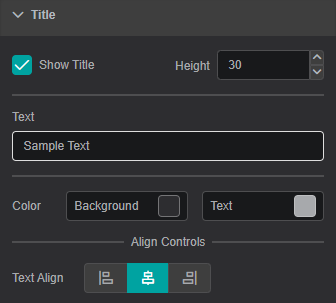
| Property Name | Description |
|---|---|
| Show Title | Show/hide the title line |
| Height | Height of the title line |
| Text | Text itself |
| Background Color | Background color of the title line |
| Text Color | Text color of the title line |
| Text Align | Alignment of the text within the title line: Left, Center, Right |
Attribute Mapping
When an asset is assigned as a channel, IOTA Vue allows you to map only necessary attributes to the component. This is done via Attribute Mapping, which exists for every asset channel.
In fact, Attribute Mapping is tied to the template of the asset. You can edit or remove the selected Attribute Mapping.
Note
This section is shown in the component settings only if there is an asset mapped to the component.
Properties
Using the Attribute Mapping Dialog you can add attributes to the current mapping and change their properties:
- Add attributes to the current mapping one by one with the
Addbutton or all at once with theAdd Allbutton - To hide an attribute click on
Toggle Visibility - To access to Attributes properties click on
Properties - To save the attribute mapping (without adding the current channel) press
Train Only - To save the attribute mapping and add the current channel press
Train and Add - To exit the screen without saving your changes, press
Close
Global Time Control
To activate the Global Time Control panel click on button in the upper area of the
View:

Additionally, you can configure the Global Time Control option in Settings for every component on the current display.
Use Component as Global Time Control: if enabled, the component is able to set the time context for all components on the current display.Ignore Global Time Control: when enabled, the option allows the component to function independent of global time set elsewhere.
The example below demonstrates the usage of the Global Time Control panel and how the value changes in the space of an hour:
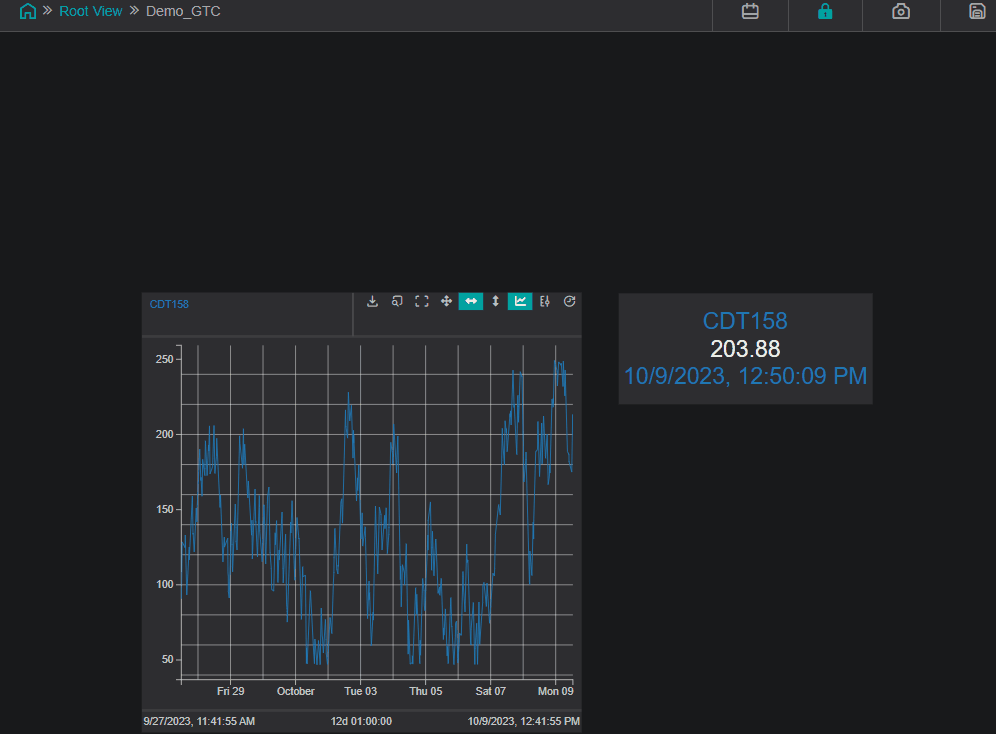
Channels
The Channels section lists data that is assigned/mapped onto the component.
In this menu, you can change the data value color, adjust the display properties and un-assign or remove the data from the component.
Properties
The properties menu for Channels allows you:
- to modify the Label of the DataSource
- to set UOM, lower and upper values
- to choose number format and displayed digits
- to adjust the line formatting for trend line components
- to configure the additional regression lines that can be plotted for supported components
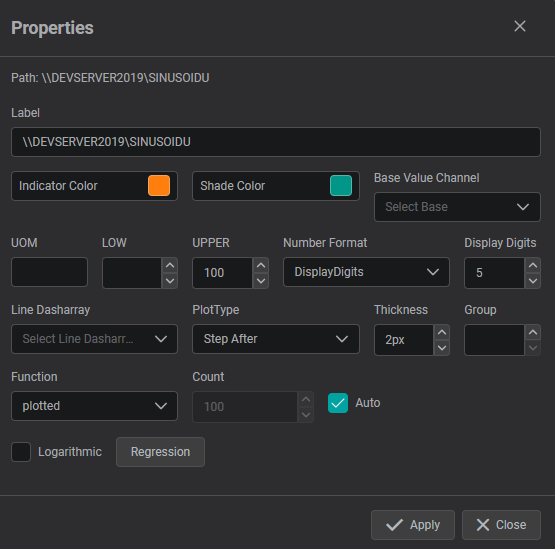
Supported Multi-State Parameters
Each of the the visual parameters listed below can be used as a multi-state, i.e. used in actions and scripts:
- Title and Text
- Text
- Rotation and Position
- Rotation
- Common
- Blink
- Hidden
- Title
- Show Title
- Title Padding
- Title Height
- Title Text
- Title Background Color
- Title Color
- Title Text Align
- Visual Properties
- Border Color
- Border Width
- Border Radius
- Background Color
- Delta Up Color
- Delta Down Color
- Label Color
- Timestamp Color
- Value Color
- UOM Color
- Font
- Title Font Family
- Title Font Size
- Title Font Italic
- Title Font Bold
- Title Font Underline
- Legend Property
- Legend Font Family
- Legend Font Size
- Legend Italic
- Legend Bold
- Legend Underline
- Format
- Legend Position
- Legend H-Align
- Legend V-Align
- Legend H-Padding
- Legend V-Padding
- Label Source
- Custom Label
- Custom UOM
- Number Format
- Inner radius
- Transpose
- Global Time Control
- ignored
Pie Chart Settings
Visual Properties
The Visual Properties section provides options for customizing the component's appearance by changing the color schema.

Border Color: Defines the component's border colorBorder Width: Adjusts the thickness of the border frame. Default: 0 - invisible borderBorder Radius: Defines the curvature of the component’s cornersBackground Color: Defines the component's background colorValue Delta Up: Defines the color of the delta triangle when the trend is going upValue Delta Down: Defines the color of the delta triangle when the trend is going down
Delta
The delta triangle represents the following trends:
Up: Indicates the current value is higher than the previous valueDown: Indicates the current value is lower than the previous value
If there has been no change in the value since the last update, the delta triangle will not be displayed.
To pick color of your interest
- To change color for specific visual property, click on the color box next to property description. The color picker dialog will be displayed.

- Pick the color of interest. The video below shows how to choose a solid, gradient or theme color.
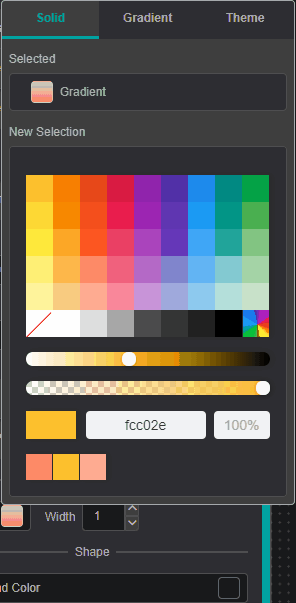
You can add Gradient Stops by double clicking and to remove - by pulling it up.
- To close the color-picker dialog - click on the property color box (Step 1).
Closing color-picker dialog
Clicking on the workspace area instead of Settings Tab area -
component settings will disappear since component focus will be lost.
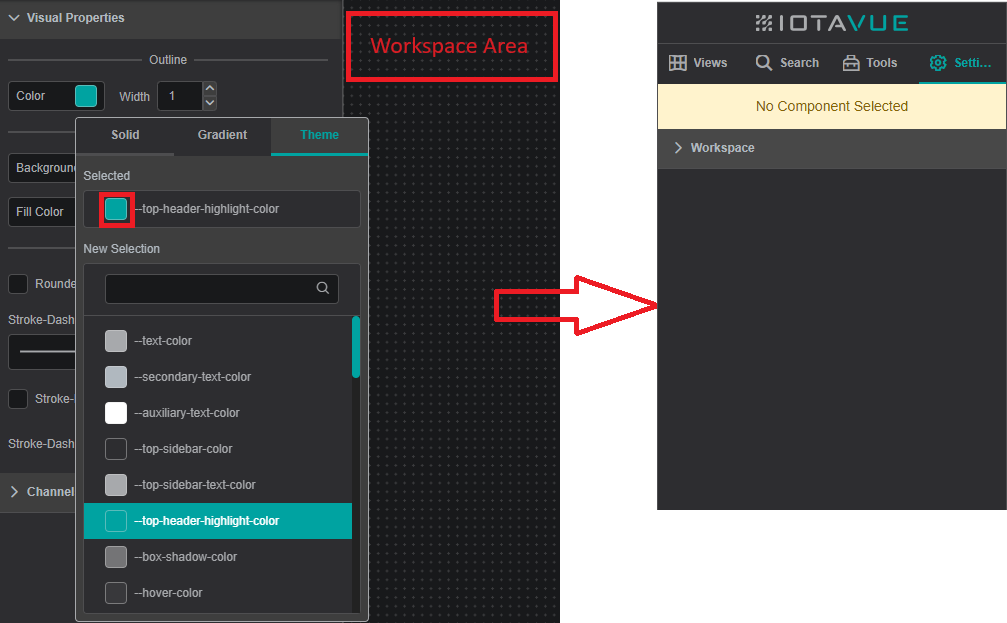
Tooltip
The Tooltip Setting provides data reference for PI AF attributes and descriptive statistics when user interacts with a component by hovering over it.
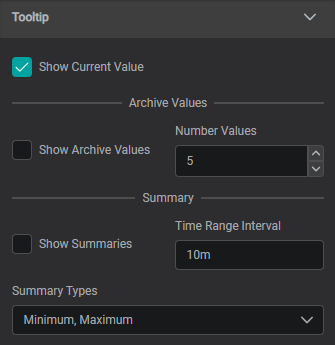
Show Current Value: Shows Current ValueShow Archive Values: Shows Archive Values, the number can be set inNumber ValuesShow Summaries: Shows Summaries for set Time Range Interval (can be set in seconds (s), minutes (m), hours (h), days (d), weeks (w), months (mo), years (y))
Summary Types :
Average: the average value in the set periodMinimum: the minimum value in the set periodMaximum: the maximum value in the set periodPercentGood: the percent good value in the set periodStdDeviation: The standard deviation of the value in the set periodPStdDeviation: The percent standard deviation of the value in the set periodTotal: The sum of the values in the set periodCount: The number of data points in the set periodRange: The difference between the largest and smallest value in the set period
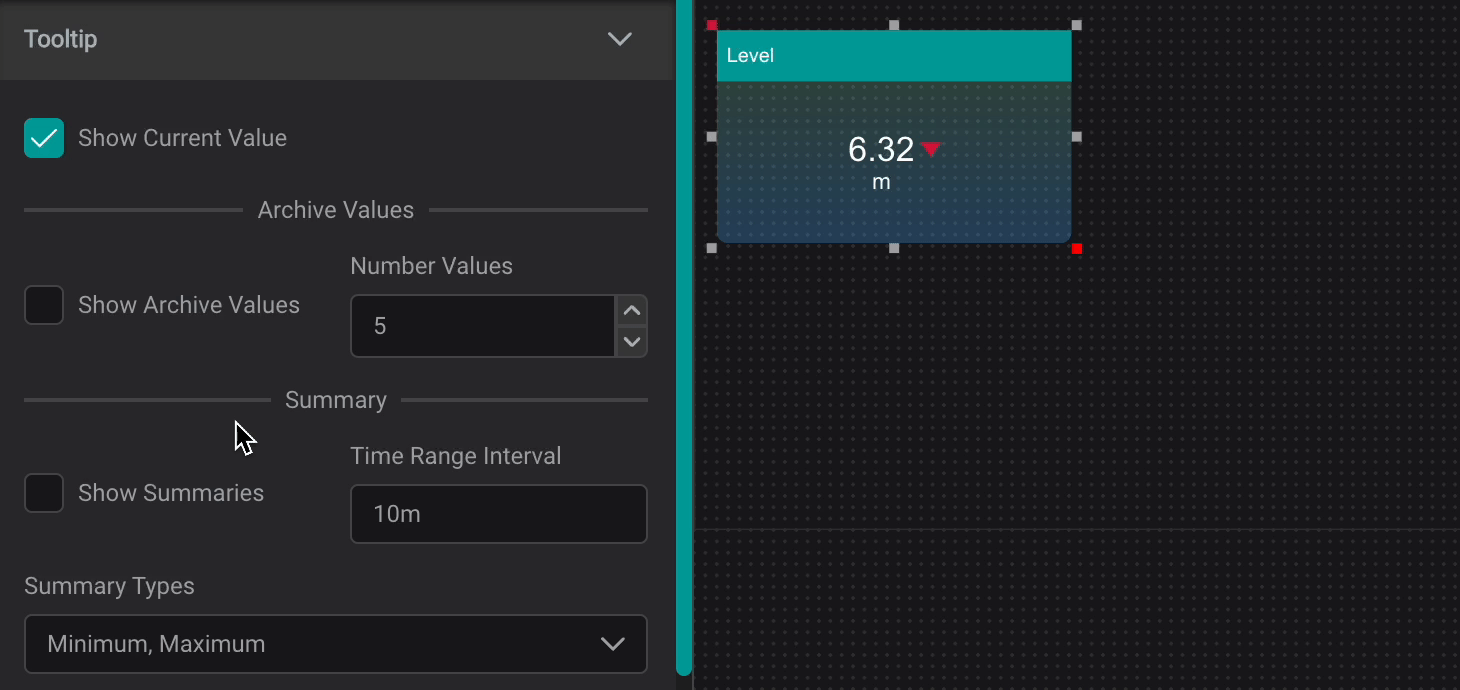
Legend Colors
The Legend Colors section defines colors for:
- Value
- Label
- Timestamp
- Unit of Measure (UOM)

Tip
By default, the legend colors are transparent and show the assigned channel color. To revert back to this setting, simply choose the transparent option. To configure the channel colors, refer to the Channel section in Generic Settings.
The Toggle Synchronization button allows you to synchronize all the component properties to a desired color.
When the Toggle Synchronization button is disabled in Legend Colors, you can change the color of each property one by one.

If you want all the legend properties to have the same color, enable the synchronization mode
by clicking on the Toggle Synchronization button. In this mode, a change to any legend property color will automatically adjust all other
legend properties to the same color.

Note
The Legend Colors section is common among many components, so it is described using general visual examples, which may differ slightly from one component to another. However, the logic and behavior stays the same.
Font
The Font section provides options for customizing the legend font properties.

Font Properties
Font properties available for edit:
Font Family: Allows to select different font family. Default: ArialFont Size: Controls the font size. Default: 12Italic: Sets font to italicBold: Sets font to boldUnderline: Sets font to underline
Font Legend
The Legend section allows to change font properties for selected Legend Property: Value, Label, Timestamp or UOM.
Info
The Font Legend section is common among many components, so it is described generally and may differ slightly from component to component.
When Toggle Synchronization button is disabled, you can change the properties of the legend individually.
Or enable Toggle Synchronization to synchronize all the properties with the one currently selected in Legend Property field.
Format
The Format section provides options for customizing displayed information.
Inner Radius
The Inner Radius setting modifies the size of the pie chart's central hole.

By default, the pie chart does not display an inner radius hole (Inner Radius = 0). However, you can customize the radius to create a central hole that is either half- or quarter-sized:

Legend Position

The Position drop-down menu allows to set the placement of the legend in relation to the component: top, bottom, left, right, center.
Legend Layout
The legend arranger allows you to change the legend's layout for: Value, Label, Timestamp, UOM and Delta.
To display a property, drag it to the desired location within the grid. Once placed, you can align the property both vertically and horizontally using the controls underneath the grid.

Info
If you select the legend position as top, bottom, or center, you can only use the horizontal alignment options. If you select the legend position as right or left, you can only use the vertical alignment options.

H-Padding: defines the horizontal paddingV-Padding: defines the vertical padding
The Transpose check box allows to flip the legend vertically/horizontally.
Legend Data Format
The following options are available for customizing your legend:

Label Source: defines the source for the labelName: the label is set to the name of the channel/attributeChannel Label: the label comes from channel/attribute mapping if trainedPath: the label is set to the asset path plus the name of the attribute (works only for assets)AssetPath: the label is set to the asset pathDataReference: works for PI AF data sources. if the channel is an attribute of Pi Point data reference- show the data reference configuration (i.e. pi data archive and tag) in a format \pidataarchive\tagname - the format is specific to piDescription: the label is set to the description of the channel/attributeCustom: the label is set to theCustom Labelfield
Path Levels: defines the path level fo the label ifLabel Sourceis set to Path or AssetpathCustom Labelallows to set a custom LabelCustom UOM: allows to define custom Units of Measure (UOM)
Number Format
The Number Format allows you to define the numeric representation of the legend's Value property.
IOTA supports custom formats (for more information please click ). If using a custom format, simply type the desired format in the box under
Number Format.
Number Format Examples
| Number Format | Displayed Value |
|---|---|
| General | 2376.28 |
| 0 | 2376 |
| 0.0 | 2376.3 |
| 0.00 | 2376.28 |
| 0.000 | 2376.280 |
| #,##0 | 2,376 |
| #,##0.0 | 2,376.3 |
| #,##0.00 | 2,376.28 |
| #,##0.000 | 2,376.280 |
| (#,##0) | (2,376) |
| (#,##0.00) | (2,376.28) |
| 0% | 237628% |
| 00.0% | 237628.0% |
| Scientific | 2.38E+3 |
| Channel | 2376.28* |
| System | 2376.28** |
* as in the database
** as in the system
Examples
Tags
To quickly start using the Pie Chart component, simply search for a specific tag and drag it onto the component:

To visualize multiple tags within a single Pie chart, select several tags and drag them onto the dashboard:

Timeframes

